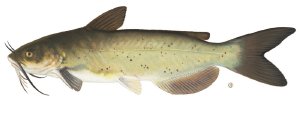Jul 26 2009
Nearly all species have some ability to detect light. At least three types of cells in the retina allow us to see images or distinguish between night and day. Now, researchers at the Johns Hopkins School of Medicine have discovered in fish yet another type of cell that can sense light and contribute to vision.
 catfish
catfish
Reporting in this week’s Nature, the team of neuroscientists shows that retinal horizontal cells, which are nerve cells once thought only to talk to neighboring nerve cells and not even to the brain, are light sensitive themselves.
“This is mind-boggling,” says King-Wai Yau, Ph.D., a professor of neuroscience at the Solomon H. Snyder Department of Neuroscience at Johns Hopkins.
“For more than 100 years, it’s been known that rod cells and cone cells are responsible for sensing light, and therefore, vision,” says Yau. “Then, about seven years ago, another light sensor was discovered in the retina, revealing a third type of light-sensitive cells in mammals, so we set out to look at whether this was true in other vertebrates as well.”
Focusing their efforts on the melanopsin light sensor, which is responsible for sensing day and night but barely involved — in mammals, at least — in seeing images, Yau’s team looked for melanopsin-containing cells in other vertebrates, and found some in the retinal horizontal cells in goldfish and catfish.
Catfish contain two flavors of retinal horizontal cells: those that connect to cone cells, which respond to bright light, and those that connect to rod cells, which respond to dim light. The team took electrical readings from single isolated retinal horizontal cells. They found that light caused a change in electrical current in cone horizontal cells but not in rod horizontal cells.
Horizontal cells, says Yau, allow cross-talk between neighboring photoreceptor cells, allowing these cells to compare the light they sense, a process necessary for the brain to see images. “The brain processes what it sees in context to the surroundings,” says Yau. “This allows our brain to see borders and contours—horizontal cells are the reason why we can recognize and see a face, for example.”
Testing light at different wavelengths, the team found that these fish horizontal cells are thousands of times less light sensitive than their partner cone cells.
“The bottom line is that the light effect on the horizontal cells is subtle, perhaps to allow the eyes of these animals to fine-tune their functions to different ambient light conditions,” says Yau. “But that these horizontal cells are light sensitive at all is a very surprising finding and changes how we think about retinas as a whole.”
Learning more about how the light sensitivity of horizontal cells contributes to image vision will require studying whole retinas, not just single cells. Yau, whose goal is to understand vision, is hooked. “Maybe,” he says, “there are still other photosensitive cells in the eye that we don’t know about yet.”
This study was funded by the National Institutes of Health and the António Champalimaud Vision Award.
Authors on the paper are Ning Cheng, Takashi Tsunenari and Yau, all of Johns Hopkins.